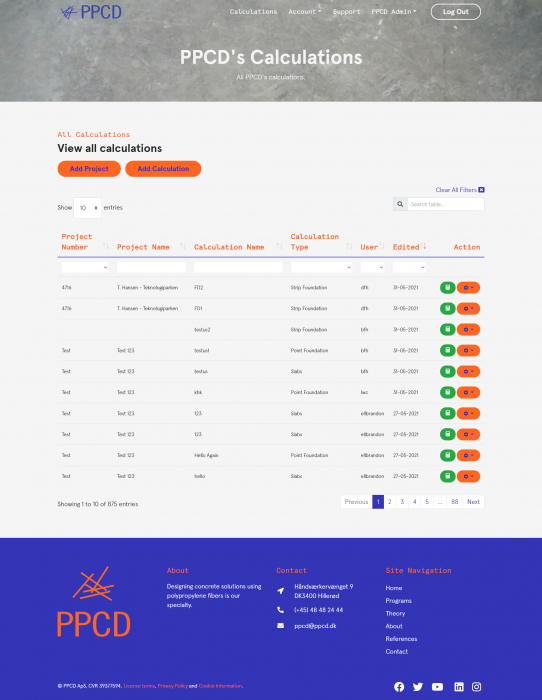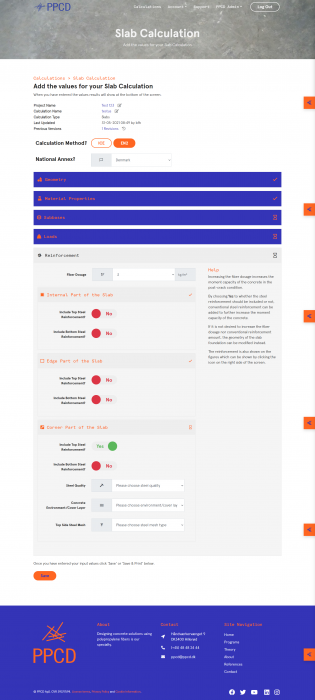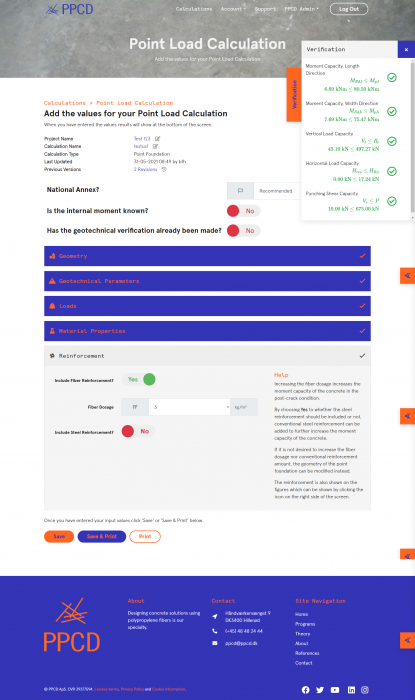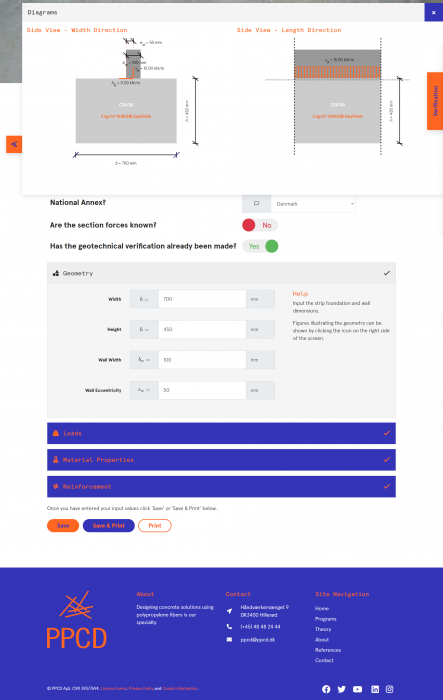I. SUMMARY INFORMATION
Project
269090
Status
Submitted
Award category
Techniques, materials and processes for construction and design
You want to submit
NEW EUROPEAN BAUHAUS AWARDS : existing completed examples
Project title
Polypropylene (PP) fiber reinforcement
Full project title
Online programs for calculating with polypropylene (PP) fiber reinforcement in concrete structures
Description
Using polypropylene (PP) fiber reinforcement instead of steel reinforcement in concrete structures, the CO2-emission is reduced with more than 60% on the reinforcement, while providing easier quality control, a safer work environment, and reduced working hours and cost. PPCD has developed online programs for calculating the required dosage of PP fiber reinforcement in various concrete structures. The programs are available for everyone, so we can start saving the planet together!
Where was your project implemented in the EU?
Denmark
Region Hovedstaden
Æbeløgade 27, 2.t.h.
København Ø
2100
When was your project implemented?
Has your project benefited from EU programmes or funds?
No
Which programme(s) or fund(s)? Provide the name of the programme(s)/fund(s), the strand/action line as relevant and the year.
II. DESCRIPTION OF THE PROJECT
Please provide a summary of your project
PPCD is a company that developes online programs that can be used to calculate, analyse, design, and document a variety of concrete structures using polypropylene fiber reinforcement instead of or in combination with conventational steel reinforcement. Polypropylene fiber reinforcement is a much more CO2-friendly reinforcement, compared to conventional steel reinforcement and steel fiber reinforcement.
The programs consist of very user-friendly input pages, using questionnaires to reduce the amount of input fields to an absolute minimum, while still making it possible to compute all the calculations. A pull-out tab can be clicked showing live illustrations and diagrams of the input parameters that are being filled in. When all the required input fields have been filled in, another pull-out tab will show a verification of whether the bearing capacity is sufficient. Once a satisfactory design has been completed an extensive documentation necessary to get a building permit is auto-generated. The programs are designed to increase the effectiveness of these civil engineering calculations, and will make the work process more efficient and streamlined.
Daniel Fester Henningsen gives a summary in this video: https://www.youtube.com/watch?v=TkqLM7pvXd4
Please give information about the key objectives of your project in terms of sustainability and how these have been met
As mentioned above the polypropylene fibers, which can be documented as structural reinforcement in concrete using the calculation programs, are much more CO2-friendly than conventional steel rebar or steel fibers. This can be proved through the comparison of typical concrete structures using the relevant Environmental Product Declaration (EPD) for the fibers and the steel. The EPD of the default fiber type in the calculation programs, DURUS® EasyFinish polypropylene fibers, has been published by EPD Danmark and is accessible on EPD Danmark’s database and also linked on the PPCD webpage. The CO2 savings on the reinforcement in for example a ground supported slab is typically in the range 60-90%.
The CO2 savings are further emphasized by the calculation programs in terms of pure concrete savings, as the quick and simple user interface implores the user to find the most optimal dimensions of the concrete element.
The above mentioned CO2 savings can therefore easily be attained in almost any construction project by any civil engineer who chooses to use the developed calculation programs and design a fiber reinforced element when applicable.
Please give information about the key objectives of your project in terms of aesthetics and quality of experience beyond functionality and how these have been met
PPCD has developed programs that examine and verify the bearing capacity of the types of constructions in question, for all loads, internal forces and scenarios, using a minimum of input fields for ease of use. Moreover, documentation is autogenerated that clearly illustrates the input parameters, prerequisites and calculations. The idea is to create a clear-cut and operational interface that makes it easier to make an optimized design where the use of conventional steel reinforcement can be avoided or reduced by the use of the more environmentally friendly polypropylene fiber reinforcement. The workflow, overview, and file management are enhanced by the programs all the way from input to output by the use of helpful figures, symbols, and databases.
Please give information about the key objectives of your project in terms of inclusion and how these have been met
Not only are the DURUS® EasyFinish fibers produced and tested according to European Standards, but the online calculation programs also follow all parts of the European Standards and Model Code relevant to fiber reinforcement. The calculation programs can therefore be used all over Europe and also includes the option of specifying relevant national annex parameters through a drop down menu at the beginning of each calculation.
The monthly subscription is cheap and flexible. The floating licenses for each program can be purchased separately and added and removed during the month for maximum flexibility. Pricing of the calculation programs are based on the amount of programs the user adds to their tool box and the amount of users per program. The more they buy, the bigger the discount.
Please give information on the results/impacts achieved by your project in relation to the category you apply for
The customers, whether they are contractors, manufacturers or consultants, will have a basis for documenting the use of polypropylene fibers in various types of constructions and elements because with the program, they can tender the necessary presentation and static documentation. On the basis of the documentation that the programs automatically create, the use of fibers will be able to expand and the resulting advantages for the users, builders and contractors are:
• Work processes are made easier, including transport, handling and processing, which in the final instance saves time.
• Better working environment without sharp reinforcing steel and heavy lifting including use of cranes.
• A reduction in carbon dioxide emission for e.g., a typical slab of up to 93%.
• The product can be documented in a cradle to cradle process because the fibers can be recovered by crushing the concrete and then be recycled.
• Can be used as plastic shrinkage crack-reduction reinforcement.
• Can be used as long-term shrinkage crack-reducing reinforcement.
• No corrosion and easier handling since the fibers do not have to be laid out and there is no need to consider cover layers.
• The fibers can be applied as bending and shear reinforcement meaning that the end user has the advantage of avoiding stirrups and cage reinforcement.
There are at this time, approx. 30 users, including users in the Baltic countries, England, Norway, Sweden, Poland, and Belgium, with many more international users expected over time.
Please explain the way citizens benefiting from or affected by the project and civil society have been involved in the project and what has been the impact of this involvement on the project
The great demand for easier, cheaper, and faster construction solutions from the contractors has definitely led PPCD to investigate and develop the use of fiber reinforced concrete to types of structures other than slabs, such as point foundations and strip foundations.
Please highlight the innovative character of the project
Although the calculation technology and theory are recognized, they are not well established, and therefore not only has the development of the program been innovative, but especially the issue of implementing the technology in a more user-friendly interface. There is known scientific documentation surrounding the function and utilization of polypropylene fibers, but not from a single reference such as Eurocode. Therefore, the process has primarily consisted of collecting, coordinating and verifying these complex and technical theories to get an overview before turning the theory into programs with a useful, accessible and intuitive interface.
The programs make the application of polypropylene fibers more accessible and thus more widespread, and the programs can both economically and environmentally contribute to Denmark’s position as a pioneer in environmentally correct design and support the Danish Concrete Society’s (Betonforeningens) goal of making concrete more environmentally correct.
Furthermore, to our knowledge, no other software or engineering company provides programs for calculating with fiber reinforcement. Especially not with such variety of use, userfriendlyness and extensive design and documentation features. Lastly, the programs are online and easily accessible, making it possible for everyone to calculate with and advice the use of polypropylene fiber reinforcement, so that we can start saving the planet together.
Please explain how the project led to results or learnings which could be transferred to other interested parties
In these types of projects PPCD has definitely learned that it is important to work with a supplier or contracter in order to have the necessary support and network required to establish the theory in practice.
Is an evaluation report or any relevant independent evaluation source available?
No
III. UPLOAD PICTURES
IV. VALIDATION
By ticking this box, you declare that all the information provided in this form is factually correct, that the proposed project has not been proposed for the Awards more than once under the same category and that it has not been subject to any type of investigation, which could lead to a financial correction because of irregularities or fraud.
Yes





